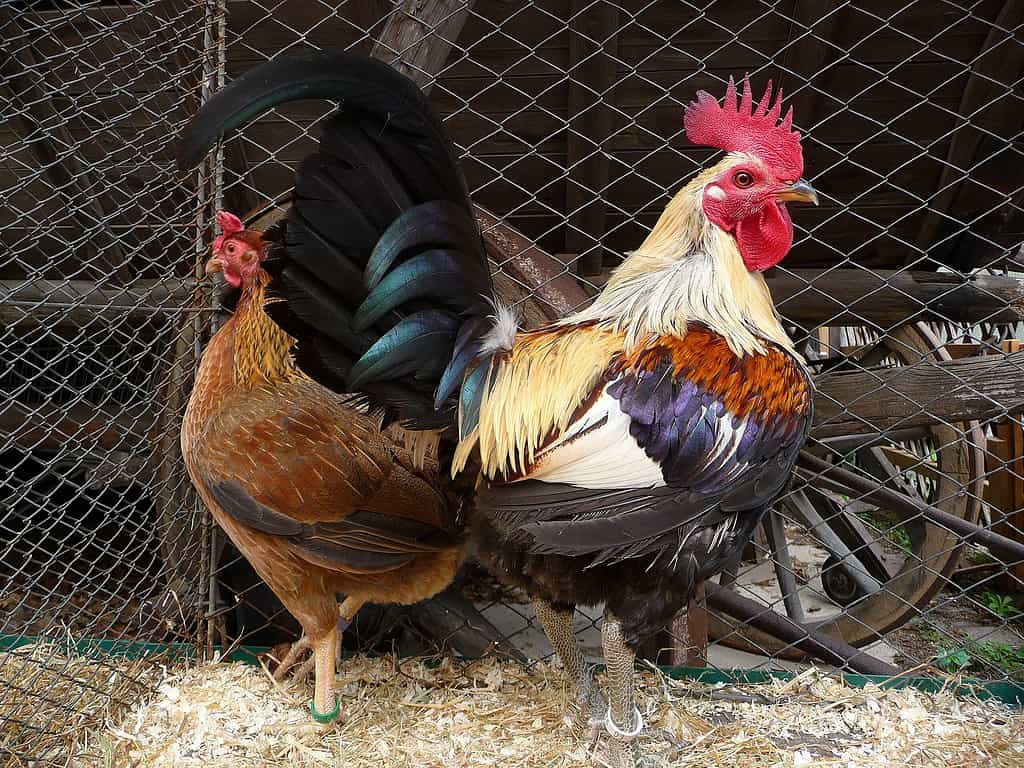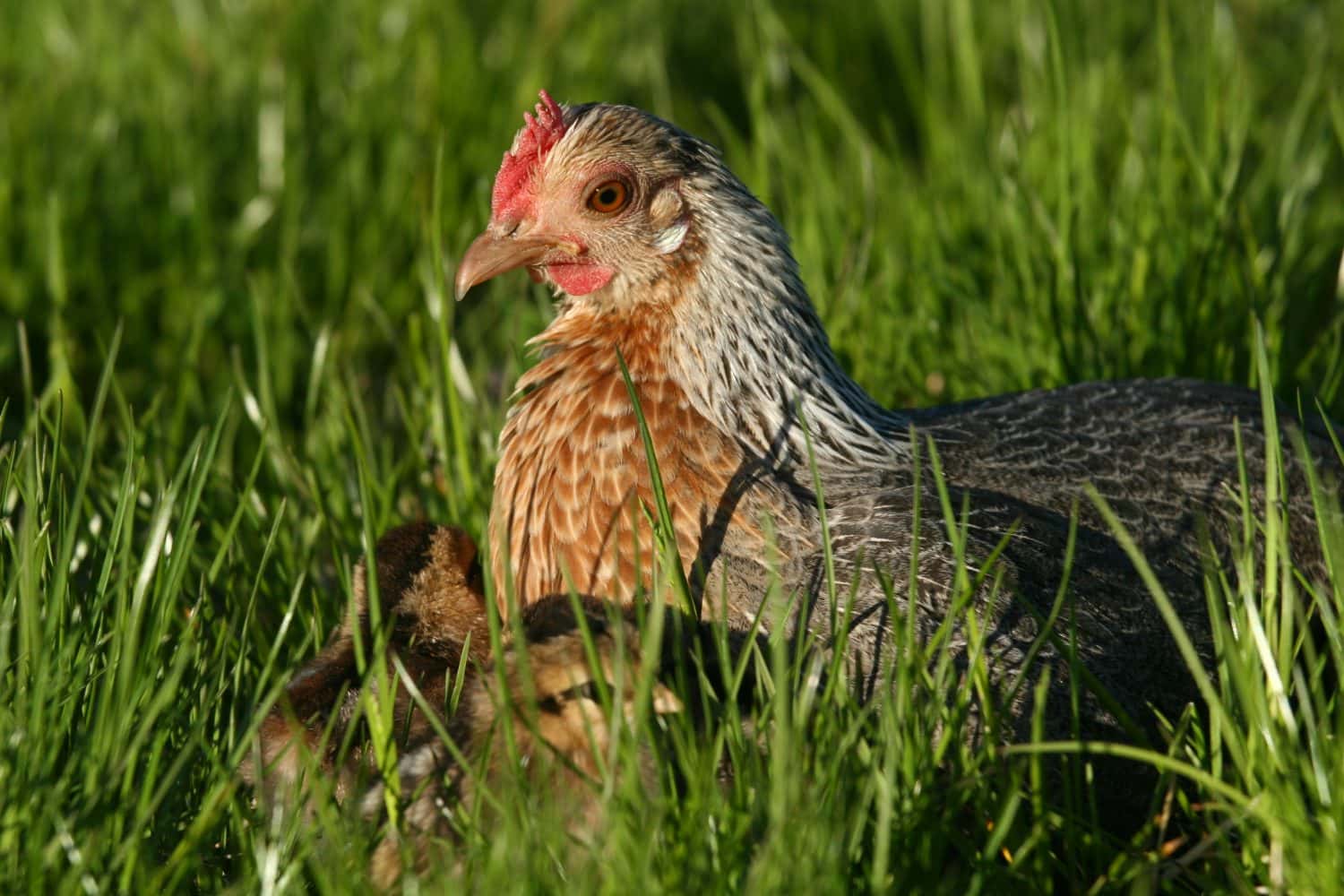If you are looking for an ornate chicken that closely resembles the jungle fowl from which domestic chickens arose, the Old English Game chicken may be your best bet. This small breed retains many of the qualities of its wild ancestor, and it comes in colors unseen in other breeds. Of course, you will have to accept their aggressive, almost feral nature. This isn’t a cuddly chicken breed, and if you don’t keep your flock well enclosed, you might find your birds roosting in nearby trees. Read on to learn all about the Old English Game chicken.
Old English Game Chicken Breed History

The athletic look of the Old English Game chicken derives from their ancestors.
©caseyjadew/Shutterstock.com
The Old English Game chicken is a product of blood sport. These birds descended from fighting fowl that were imported to the region by Romans as early as the first century. They developed at a time when cock-fighting was not only socially acceptable, but extremely popular across all the social strata in Great Britain, and indeed around much of the world. Eventually, the popularity of this so-called sport waned as people began to recognize the cruelty involved. By 1849, the activity was banned in England.
With no more titles on the line, and no more bouts to legally fight, the Old English Game chicken could have slipped into obscurity if not for poultry shows. Breed enthusiasts pivoted from raising their birds for fighting to raising them for exhibition. Two separate clubs emerged in 1930 in England, one near the city of Oxford and another in Carlisle. The Carlisle variety and the Oxford variety varied slightly in breed standards.
Characteristics

Old English Game roosters are considerably more ornate than hens.
The Old English Game chicken is among the smaller full-sized chickens. Roosters reach weights of about 4 to 5 pounds, while hens only get to be about 3.5 to 4 pounds. The bantam-sized variety weighs less than its full-sized counterpart. Bantam roosters weigh about 1.3 to 1.6 pounds, while bantam hens reach only about 1.1 to 1.3 pounds.
Although the Old English Game chicken has a small body, it maintains a muscular and athletic form hearkening back to its fighting heritage. In England, these fowl should have sleek, tight feathers. In the United States, the breed may have looser feathers with longer ornamental hackle and saddle feathers. Roosters should have broad, curved, and glossy tail feathers. Hens have shorter tails with some volume.
Both roosters and hens should have strong, long necks. They usually hold their heads up high. They should have an alert, confident appearance. Old English Game chickens have white skin. They have single red combs and small red wattles. They also have large, slightly curved beaks, short legs, and strong feet with widespread toes that bear long nails.
The Carlisle variety of the Old English Game chicken has a horizontal back. The Oxford variety has a back angled at around 45 degrees from the ground.
Color Patterns
Old English Game fowl are among the most colorful in the world. Some color variations recognized in this breed do not exist in any other breed. The Poultry Club of Great Britain recognizes 13 different colors in the Carlisle variety and more than 30 different colors in the Oxford variety. Virtually no color variation is rejected among Oxford variety Old English Game fowl, so long as the chicken meets the breed standards.
Other European countries recognize a total of 33 different colors. Meanwhile, in the United States, the American Poultry Association recognizes 14 different color variations in the large fowl and 28 different colors in the bantam size.
Temperament

Old English Game chickens have an aggressive temperament and tend toward a feral nature.
©fotograficu/Shutterstock.com
Old English Game fowl, like other breeds derived from fighting birds, have among the most aggressive temperaments of all chickens. Even though this breed runs smaller than most, it maintains an upright posture and walks the yard with utter confidence. Old English Game chickens are very active birds that tend to make quite a bit of noise. These birds may attempt to bully other breeds, regardless of their size. They also tend toward flightiness and owners may have a hard time keeping them in an area without a covered enclosure. They have an independent streak that may lead free-ranging individuals to become feral rather than return to the safety of the coop.
Old English Game Chicken Eggs

Old English Game hens only produce about 100 to 160 eggs per year.
©Michael Woodruff/Shutterstock.com
This breed produces between 100 to 160 medium-sized eggs per year. That equals an average of about two to three eggs per week. The eggs are white or just slightly tinted. Owners typically do not choose to raise Old English Game chickens for their egg production.
Meat Production
As small birds, Old English Game fowl do not produce large quantities of meat. But because of their muscular, evenly distributed build, they are considered very good quality table birds. Most of these chickens are raised for strictly ornamental purposes, but they make fine dinner birds, too.
Old English Game Chicken Prices
As of this writing, Old English Game chickens are available for pre-order for the 2024 spring shipping season. The standard-sized birds run approximately $12.50 for each chick, with shipping added to the total. Bantam chicks cost between about $5.50 and $6.50 per chick, depending on the hatchery you choose. The cost of this breed exceeds many of the more common chickens but is less than many rare varieties.
The photo featured at the top of this post is © Vronja_Photon/iStock via Getty Images
Thank you for reading! Have some feedback for us? Contact the AZ Animals editorial team.







